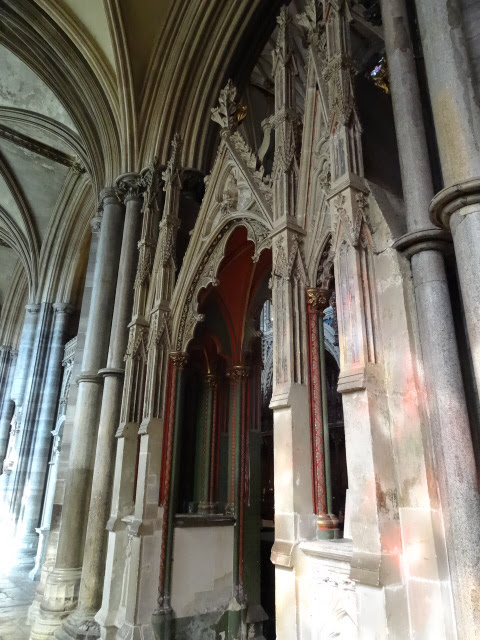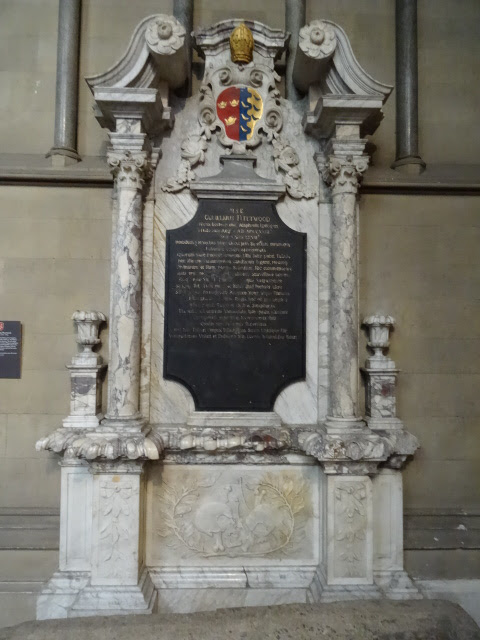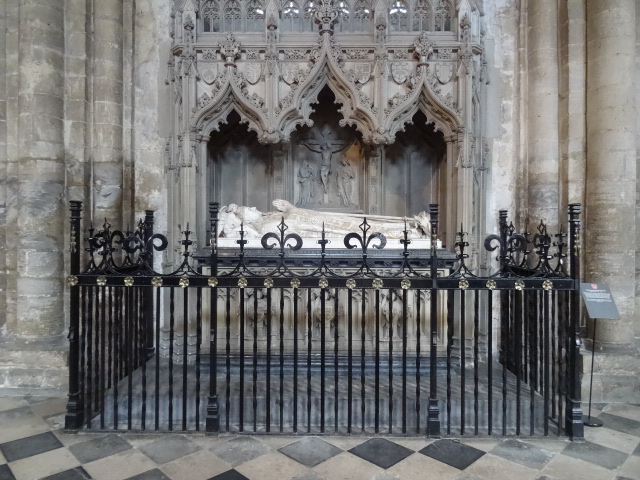Finally, to the furnishings. And it must be said that Ely is particularly rich in them. Their distribution is however not only uneven 'geographically' throughout the building (the majority are in the eastern limb), but chronologically (the majority are post-Reformation). The latter is to be expected in a country where the Reformation was not Lutheran, but was, at times, decidedly 'Reformed'. Time and neglect have done the rest. Perhaps it might be valuable to see the cathedral subject to a series of tides that have both scoured the building of furnishings and left a flotsam of new ones in their place. It also illustrates that we assume erroneously that buildings like cathedrals exist is some sort of stasis, when by their very nature the opposite is true.
The most important survivals from the Middle Ages are the Choir Stalls (1338-48), and the funerary monuments. In particular there are the Tournai marble tomb of an unknown bishop; the Purbeck marble tombs of Bishop Kilkenny and Bishop Northwold; and the tomb of Bishop Redman which is credited to John Wastell - we've seen his work so far at Peterborough Cathedral, and King's College Chapel, Cambridge. Very little Medieval stained glass survived the onslaught of the iconoclasts - the overwhelming number of such windows in the cathedral today are Victorian. In a similar manner nearly all the liturgical furnishings are Victorian or later.
Little survives of the period between the Reformation and the arrival in 1770 of James Essex except a series of fine Baroque monuments. Sadly, the rather fine marble font was exiled from the cathedral at some point during the 19th century; the bowl is in Prickwillow church, but the canopy has been lost. For shame. Late 17th century, it was the sort of thing you might in a Wren church in the City of London. Of Essex's work at Ely next to nothing survives with the exception of two paintings in the s transept that served, in turn, as altarpieces for his High Altar. Some it, surely, must have been ok? And that takes us neatly to the work of Sir George Gilbert Scott - where to begin? Perhaps with the fine Italianate iron screens in the chancel aisles. Scott also designed the new High Altar and its sumptuous reredos, the accompanying gasoliers, the marble and encaustic flooring of the choir and sanctuary, the organ case, the pulpit, and the choir screen. It is perhaps no surprise to find that his time at Ely lasted some 30 years, no surprise either that his work has come in for some heavy criticism since. Whatever its merits stylistically the craftsmanship is top notch.
In the nave are two sumptuous tombs in the N aisle. Both Victorian. The tomb of Canon Hodge Mill by Sir George Gilbert Scott, and tomb of Bishop Woodford by Thomas Garner. In the north transept the furnishing of the Cambridgeshire War Memorial chapel is by the Arts and Crafts architect Sir Guy Dawber - more remembered for his domestic architecture. To be honest I'm not sure if I quite like it. In the 1920s Sir J N Comper furnished Bishop West's Chantry, but more of that in a further post.
In recent years a number of contemporary art works have been installed in the cathedral with mixed results. The best is, perhaps, by John Maddison in Bishop Alcock's Chantry.

















No comments:
Post a Comment